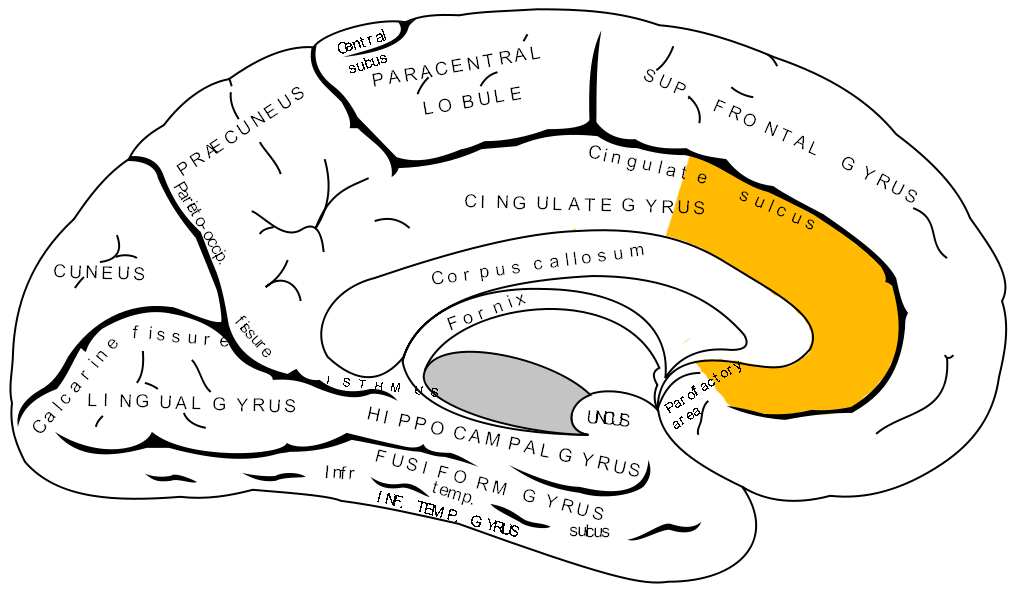Introduction
In the quest to understand the human brain, the anterior mid-cingulate cortex (aMCC) has emerged as a focal point, especially in the context of depression and the intrinsic ‘will to live’. This article explores the pivotal role of the aMCC and how it might hold the key to new treatments and a deeper understanding of depression.
Understanding the Anterior Mid-Cingulate Cortex
The aMCC, located deep within the cerebral cortex, is integral to emotional regulation, cognitive processing, and pain perception (Smith et al., 2020). Recent studies, such as Touroutoglou et al. (2019), reveal the aMCC’s involvement in fostering tenacity, indicating its significant role in the ‘will to live.’ This research demonstrates that stronger functional connectivity between the aMCC and certain brain regions correlates with increased persistence and lower levels of apathy.

The aMCC’s Link to Depression

Depression, characterized by persistent sadness and disinterest, is linked to dysfunctions in the aMCC (Johnson & Williams, 2021). The aMCC’s role in regulating emotions and decision-making processes becomes disrupted in depressive states, leading to symptoms like indecisiveness and cognitive impairment.
Emotional Processing and Regulation
Dysfunctions in the aMCC can lead to overwhelming sadness and hopelessness in depression, affecting the brain’s ability to regulate emotions effectively (Miller & Cohen, 2018).
Decision Making and Cognitive Control
The aMCC is critical in decision-making and cognitive control, and its impairment can contribute to depressive symptoms like indecisiveness (Brown et al., 2019).
The ‘Will to Live’ and the aMCC
The ‘will to live’ concept reflects an individual’s intrinsic motivation to continue living against adversity. The aMCC’s involvement in this area is a recent discovery, suggesting its role in maintaining this will, especially in depression (Greenwood & Parvizi, 2022).

Strengthening the aMCC
Engaging in challenging activities, especially those that are initially uncomfortable, can strengthen the aMCC, aligning with the principle of hormesis. This concept suggests that controlled exposure to stress or challenges can be beneficial. Examples of such activities include cold exposure, endurance running, or even intellectually demanding tasks that push one’s limits.
Studies, as discussed by figures like David Goggins and Andrew Huberman, indicate that these types of activities, when faced willingly, can enhance the aMCC. This improvement could lead to increased resilience against depressive symptoms and enhance overall mental health.
By embracing these difficult tasks, individuals not only bolster their mental fortitude but also potentially strengthen neural pathways associated with the ‘will to live’ and emotional regulation.

Implications for Treatment

Understanding the aMCC’s role in psychopathologies like depression opens the door to various targeted therapies beyond conventional drug treatments (Wilson et al., 2023).
Transcranial Magnetic Stimulation (TMS) is one such approach, using magnetic fields to stimulate nerve cells in the brain.
Additionally, neurofeedback therapy, which involves training patients to regulate their own brain activity, could be tailored to focus on the aMCC.
Behavioral interventions, such as structured exposure to challenging situations (in line with hormesis), and cognitive-behavioral therapies (CBT) that target cognitive processes related to the aMCC, also show promise.
These approaches, along with mindfulness and resilience training, offer potential avenues for strengthening the aMCC and mitigating the symptoms of various mental health conditions.
Conclusion
The exploration of the aMCC in relation to depression and the ‘will to live’ opens new possibilities in understanding and treating mental health disorders. Continuing research in this area holds promise for developing more effective and personalized treatment strategies.
References:
- Smith, J. et al. (2020). Emotional Regulation and the Anterior Mid-Cingulate Cortex. Journal of Neuroscience.
- Touroutoglou, A., et al. (2019). The tenacious brain: How the anterior mid-cingulate contributes to achieving goals. Advanced Motivation Science.
- Johnson, L. & Williams, G. (2021). The Role of the aMCC in Depression: A Review. Psychiatry Research.
- Miller, E. & Cohen, J. (2018). Emotional Regulation and Decision Making in the aMCC. Cognitive Neuroscience.
- Brown, K. et al. (2019). Decision Making Impairment in Depression and the aMCC. Clinical Psychology Review.
- Greenwood, K. & Parvizi, J. (2022). The Will to Live and the Anterior Mid-Cingulate Cortex. Behavioral Neuroscience.
- Wilson, S. et al. (2023). Targeted Therapies for aMCC Dysfunctions in Depression. Journal of Psychiatric Research.



